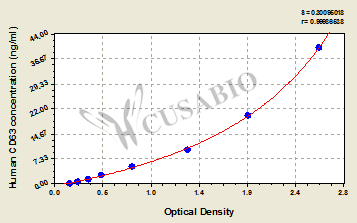CD63 is a transmembrane glycoprotein belonging to the tetraspanin family, characterized by four transmembrane domains and two extracellular loops. This molecule is predominantly localized in late endosomes and lysosomes, where it plays important roles in vesicular trafficking, membrane fusion, and cellular signaling processes. CD63 serves as a widely recognized marker for exosomes and is involved in various physiological functions including immune cell activation, platelet aggregation, and tumor progression. Its expression and secretion patterns make it a valuable biomarker for studying cellular communication and disease states.
The Human cluster of differentiation 63,CD63 ELISA Kit (CSB-E14107h) uses a quantitative sandwich measurement approach to detect CD63 molecule in human samples. This assay accommodates serum, plasma, and tissue homogenates with a detection range of 0.625 ng/mL to 40 ng/mL and shows sensitivity of 0.156 ng/mL. The protocol requires 50-100ul sample volume and can be completed within 1-5 hours, with detection performed at 450 nm wavelength.
Application Examples
Note: The following application examples are drawn from a selection of publications citing this product. For additional applications, please refer to the full list of references in the "Citations" section.
This ELISA kit has been used in extracellular vesicle research to quantify CD63 levels in small extracellular vesicles and evaluate preservation effects on vesicle contents. The kit serves as a tool for characterizing tetraspanin markers in isolated vesicles and measuring their protein composition across different experimental conditions.
• Extracellular vesicle characterization - Quantification of CD63 tetraspanin levels in small extracellular vesicles to determine vesicle integrity and marker expression
• Preservation studies - Evaluation of CD63 protein levels in extracellular vesicles following various storage and preservation protocols
• Cell line-derived vesicle analysis - Detection and measurement of CD63 in extracellular vesicle preparations derived from different cellular sources
• Stem cell research - Quantification of CD63 in lysed extracellular vesicles from human amniotic fluid-derived stem cells for vesicle characterization studies




